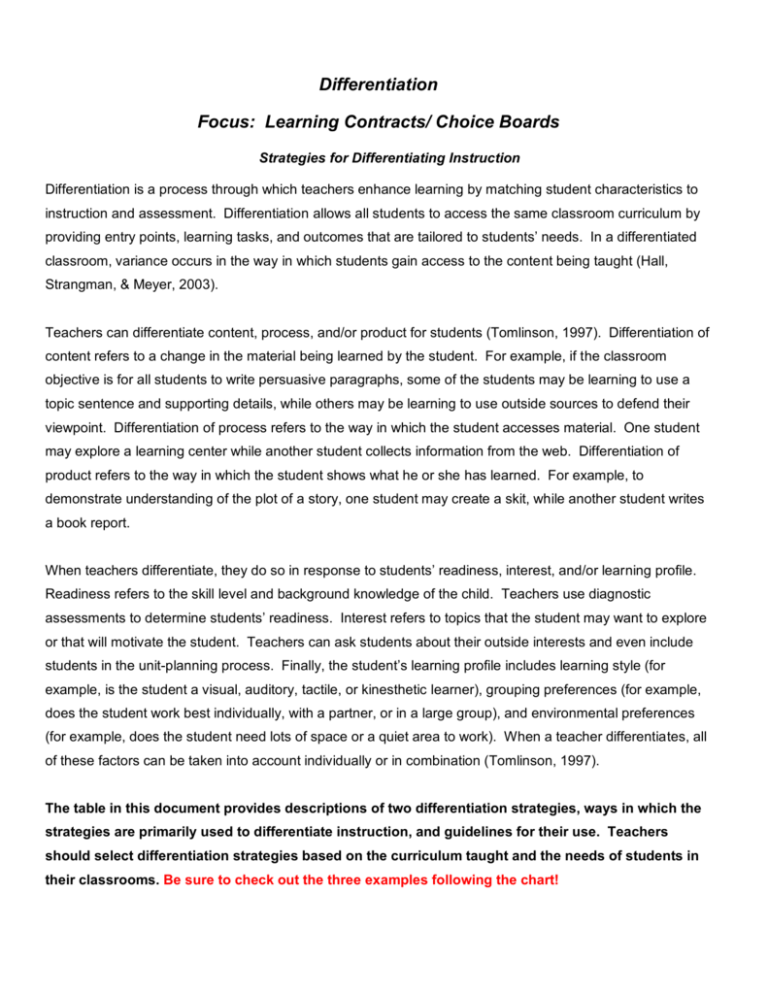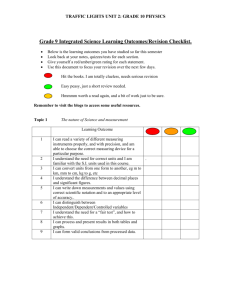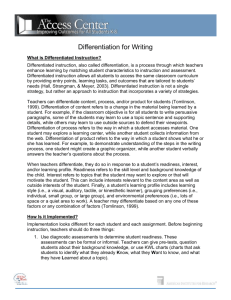Learning Contracts/ Choice Boards
advertisement

Differentiation Focus: Learning Contracts/ Choice Boards Strategies for Differentiating Instruction Differentiation is a process through which teachers enhance learning by matching student characteristics to instruction and assessment. Differentiation allows all students to access the same classroom curriculum by providing entry points, learning tasks, and outcomes that are tailored to students’ needs. In a differentiated classroom, variance occurs in the way in which students gain access to the content being taught (Hall, Strangman, & Meyer, 2003). Teachers can differentiate content, process, and/or product for students (Tomlinson, 1997). Differentiation of content refers to a change in the material being learned by the student. For example, if the classroom objective is for all students to write persuasive paragraphs, some of the students may be learning to use a topic sentence and supporting details, while others may be learning to use outside sources to defend their viewpoint. Differentiation of process refers to the way in which the student accesses material. One student may explore a learning center while another student collects information from the web. Differentiation of product refers to the way in which the student shows what he or she has learned. For example, to demonstrate understanding of the plot of a story, one student may create a skit, while another student writes a book report. When teachers differentiate, they do so in response to students’ readiness, interest, and/or learning profile. Readiness refers to the skill level and background knowledge of the child. Teachers use diagnostic assessments to determine students’ readiness. Interest refers to topics that the student may want to explore or that will motivate the student. Teachers can ask students about their outside interests and even include students in the unit-planning process. Finally, the student’s learning profile includes learning style (for example, is the student a visual, auditory, tactile, or kinesthetic learner), grouping preferences (for example, does the student work best individually, with a partner, or in a large group), and environmental preferences (for example, does the student need lots of space or a quiet area to work). When a teacher differentiates, all of these factors can be taken into account individually or in combination (Tomlinson, 1997). The table in this document provides descriptions of two differentiation strategies, ways in which the strategies are primarily used to differentiate instruction, and guidelines for their use. Teachers should select differentiation strategies based on the curriculum taught and the needs of students in their classrooms. Be sure to check out the three examples following the chart! Source:http://www.k8accesscenter.org/training_resources/documents/15HourDifferentiationModule/Handouts/HO1Diff StrategiesChart.doc Differentiation Strategy Primary Use Description of Strategy Things to Consider Learning Contracts Readiness, Learning Profiles Learning contracts begin with an agreement between the teacher and the student. The teacher specifies the necessary skills expected to be learned by the student and required components of the assignment, while the student identifies methods for completing the tasks. This strategy allows students to work at an appropriate pace and can target learning styles. Further, it helps students work independently, learn planning skills, and eliminate unnecessary skill practice. Choice Boards Readiness, Interest, Learning Profiles For example, a student completes a learning contract for a science project. He indicates that he will research the topic of mitosis, create a visual model to share with the class, and write a report. The learning contract indicates the dates by which each step of the project will be completed. Choice boards are organizers that contain a variety of activities. Students can choose one or several activities to complete as they learn a skill or develop a product. Choice boards can be organized so that students are required to choose options that focus on several different skills. For example, after students read Romeo and Juliet, students are given a choice board that contains a list of possible products for each of the following learning styles: visual, auditory, kinesthetic, and tactile. Students must complete two products from the board, and must choose these products from two different learning styles. Match skills to the readiness of the learner Allow student choice in the way in which material is accessed and products are developed Provide the contract in writing, with a clear timeline and expectations Include both skill- and contentbased learning in the contract Include choices that reflect a range of interests and learning styles Guide students in the choice of activities so that they are challenged, but not frustrated Provide clear instruction in the use of choice boards Learning Contract Example To demonstrate what I have learned about _____________________________ I want to Write a report Make a movie Put on a demonstration Create a graphic organizer or diagram Set up an experiment Other ___________________________ Develop a computer presentation ________________________________ Build a model Design a mural Write a song This will be a good way to demonstrate understanding of this concept because __________ _________________________________________________________________________ To do this project, I will need help with _________________________________________________________________________ _________________________________________________________________________ My action plan is ___________________________________________________________ _________________________________________________________________________ _________________________________________________________________________ _________________________________________________________________________ The criteria/rubric which will be used to assess my final product is ____________________ _________________________________________________________________________ _________________________________________________________________________ My project will be completed by this date: ______________________________ Student signature: ______________________________________ Date ___/___/___ Teacher signature: ______________________________________ Date ___/___/___ Diner Menu—Photosynthesis Appetizer (Everyone Shares) Write the chemical equation for photosynthesis Entrée (Select One) Draw a picture that shows what happens during photosynthesis. Write two paragraphs about what happens during photosynthesis. Create a rap or song that explains what happens during photosynthesis. Side Dishes (Select at Least Two) Define respiration, in writing. Compare photosynthesis to respiration using a Venn diagram. Write a journal entry from the point of view of a green plant. With a partner, create and perform a skit that shows the differences between photosynthesis and respiration. Dessert (Optional) Create a test to assess the teacher’s knowledge of photosynthesis. Poetry Choice Board Create a rhyming wheel (use your spelling words as a way to get started) Use your rhyming wheel (write a poem that sounds like Shel Silverstein might have written it.) Write an Acrostic poem (be sure to include alliteration) Write a cinquain Computer Art Use clip art to illustrate a simile, metaphor, or analogy on our class list Write about You Use good descriptive words in a poem that helps us know and understand something important about you. Interpret “How to Eat a Poem” Research a Famous Person Take notes. Write a clerihew that uses what you learned. Illustrate a Poem Find a poem we’ve read that you like. Illustrate it. Write about why you illustrated it as you did. Student choice #1 Student Choice #2 Student Choice #3





